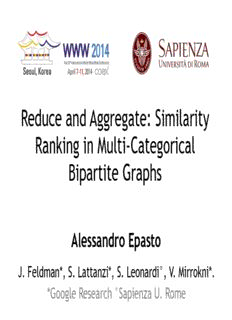
Reduce and Aggregate: Similarity Ranking in Multi-Categorical Bipartite Graphs PDF
Preview Reduce and Aggregate: Similarity Ranking in Multi-Categorical Bipartite Graphs
Reduce and Aggregate: Similarity Ranking in Multi-Categorical Bipartite Graphs Alessandro Epasto J. Feldman*, S. Lattanzi*, S. Leonardi°, V. Mirrokni*. *Google Research °Sapienza U. Rome Motivation ● Recommendation Systems: ● Bipartite graphs with Users and Items. ● Identify similar users and suggest relevant items. ● Concrete example: The AdWords case. ● Two key observations: ● Items belong to different categories. ● Graphs are often lopsided. Modeling the Data as a Bipartite Graph 2$ Retailers H u Nike Store n 3$ d New York r e 4$ d s Apparel o f L 1$ a b Soccer Shoes e l s 5$ Sport 2$ Equipment Soccer Ball Millions of Advertisers Billions of Queries Personalized PageRank For a node v (the seed) and a probability alpha v u The stationary distribution assigns a similarity score to each node in the graph w.r.t. node v. The Problem 2$ Retailers H u Nike Store n 3$ d New York r e 4$ d s Apparel o f L 1$ a b Soccer Shoes e l s 5$ Sport 2$ Equipment Soccer Ball Millions of Advertisers Billions of Queries Other Applications ● General approach applicable to several contexts: ● User, Movies, Genres: find similar users and suggest movies. ● Authors, Papers, Conferences: find related authors and suggest papers to read. Semi-Formal Problem Definition Advertisers Queries Semi-Formal Problem Definition Advertisers A Queries Semi-Formal Problem Definition Advertisers A Queries Labels: Semi-Formal Problem Definition Advertisers A Queries Goal: Find the nodes most Labels: “similar” to A.
Description: